Scholastic Bundle
How Does Scholastic Company Thrive in the World of Education?
For over a century, Scholastic has shaped young minds through the power of reading. From humble beginnings, the Scholastic Company has grown into a global leader in publishing and education. Its influence spans classrooms and homes worldwide, making it a fascinating subject for investors, educators, and anyone interested in the future of learning. Understanding How Scholastic Works is key to appreciating its impact.
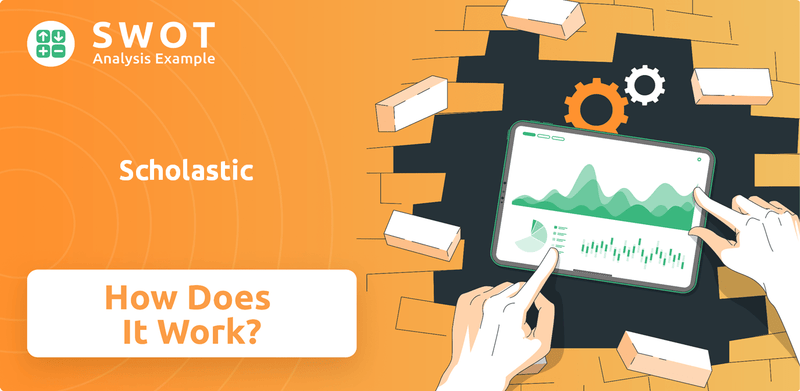
This analysis will explore the inner workings of Scholastic, examining its core business segments, including Scholastic Books, Scholastic Education, and Scholastic Publishing. We'll delve into how it generates revenue through Scholastic book clubs, Scholastic book fairs explained, and other initiatives, offering insights valuable to investors, educators, and those curious about Scholastic's history and mission. This exploration will also touch upon Scholastic reading programs, Scholastic teacher resources, and Scholastic online resources for students, providing a comprehensive view of its operations and impact on children's literacy.
What Are the Key Operations Driving Scholastic’s Success?
The core of the Scholastic Company revolves around creating and delivering educational content and resources. This includes a wide range of products, such as children's books, magazines, digital learning programs, and supplemental educational materials. The primary focus is on serving K-12 schools, teachers, parents, and children, with the goal of promoting literacy and a lifelong love of reading.
The operational processes are multifaceted, encompassing everything from author acquisition and editorial development to printing, marketing, and distribution. Key distribution channels include book clubs and book fairs, which leverage direct relationships with schools and teachers. The Education Solutions segment develops and distributes curriculum programs, professional development for educators, and technology-based learning tools.
Scholastic's value proposition lies in providing accessible, high-quality educational content and fostering reading habits through engaging platforms. The company's ability to seamlessly integrate content creation with effective distribution channels, particularly through school-based networks, sets it apart. This approach ensures that educational resources reach the target audience efficiently and effectively.
This segment manages the entire lifecycle of children's books, from acquiring authors to printing and distributing the books. Book clubs and book fairs are central to this distribution strategy, reaching millions of students. This direct access to the educational ecosystem allows for understanding and adapting to evolving needs.
Focuses on developing and distributing curriculum programs, professional development for educators, and technology-based learning tools. This involves significant investment in research and development, content creation, and robust digital platforms. This segment supports blended learning environments.
Adapts and distributes Scholastic's content globally, navigating diverse educational systems and cultural contexts. This ensures that educational resources are available worldwide. This segment allows the company to expand its reach and impact on children's literacy on a global scale.
Scholastic's supply chain involves relationships with authors, illustrators, printers, and logistics providers. Partnerships with schools and educators are crucial, forming a unique sales and distribution channel. This direct access allows Scholastic to tailor its offerings to meet specific needs.
The company's operational uniqueness lies in its ability to seamlessly integrate content creation with highly effective distribution channels, particularly through its school-based networks. This approach ensures that educational resources reach the target audience efficiently.
- Content Creation: Scholastic develops a wide array of educational materials, including books, magazines, and digital resources.
- Distribution: The company utilizes book clubs, book fairs, and direct sales to schools to distribute its products.
- Partnerships: Scholastic collaborates with schools, teachers, and authors to create and deliver educational content.
- Global Reach: The international segment adapts and distributes content worldwide, catering to diverse educational systems.
Scholastic SWOT Analysis
- Complete SWOT Breakdown
- Fully Customizable
- Editable in Excel & Word
- Professional Formatting
- Investor-Ready Format
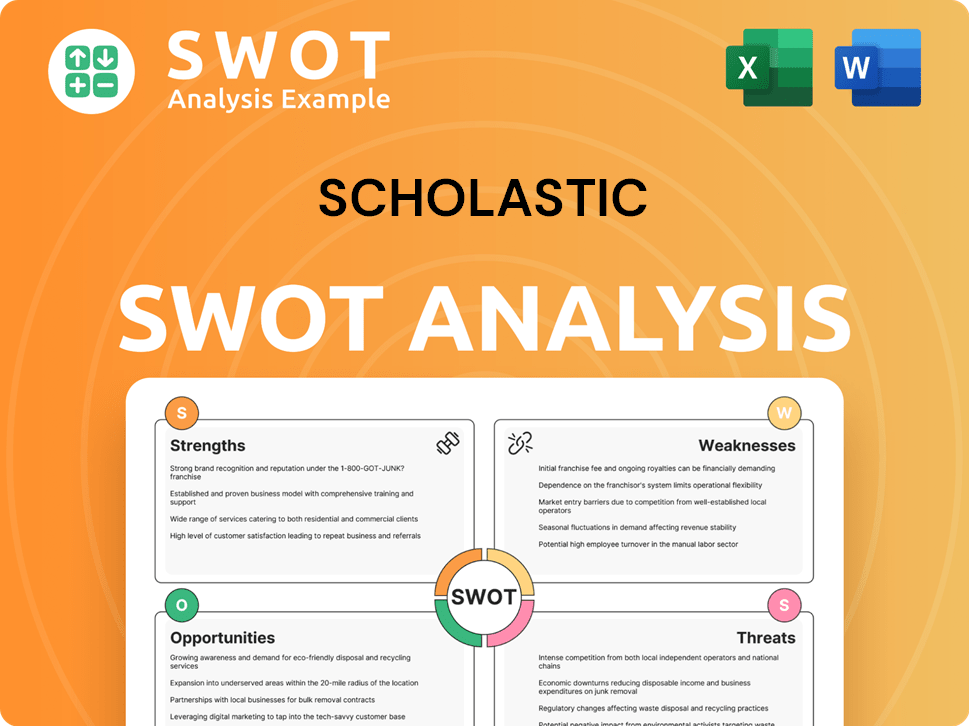
How Does Scholastic Make Money?
The Scholastic Company generates revenue through a multifaceted approach, encompassing publishing, distribution, and educational solutions. This diversified strategy allows Scholastic to tap into multiple revenue streams, ensuring a degree of financial stability. The company's revenue model is designed to cater to various segments, including children, parents, educators, and schools.
The primary revenue streams for Scholastic include product sales from its Children's Book Publishing and Distribution segment, sales of educational materials and programs from its Education Solutions segment, and international sales. These segments work in tandem to provide a comprehensive offering of books, educational resources, and services. This integrated approach supports Scholastic's mission to encourage reading and promote literacy.
In fiscal year 2024, Scholastic reported total revenue of $1.72 billion. This reflects the company's sustained presence and performance in the market. The Children's Book Publishing and Distribution segment is a significant contributor to this revenue, with the Education Solutions and International segments also playing crucial roles.
This segment includes book clubs, book fairs, and trade publishing. It is historically the largest contributor to revenue. Revenue is generated through direct sales to students and parents, and sales to retailers and libraries.
This segment offers supplemental educational products and services to schools and districts. Revenue is derived from direct sales of curriculum programs, digital subscriptions, and professional development services.
This segment encompasses operations outside the U.S. It includes sales of books and educational materials in various international markets. This segment contributes to the overall revenue and global reach of the company.
These are key components of the Children's Book Publishing and Distribution segment. They provide direct sales opportunities to students and parents, often facilitated by schools. These programs foster a love of reading and provide access to a wide selection of books.
This involves sales to retailers and libraries. The company publishes a variety of books for children and young adults. This strategy ensures that Scholastic Books are available through multiple channels.
The company has expanded its digital offerings, leading to an increase in subscription-based revenue, particularly within its Education Solutions segment. Digital platforms enhance learning experiences and provide convenient access to resources.
The company employs several monetization strategies to generate revenue. These strategies are tailored to each segment of its business. These include direct sales, subscription models, and licensing agreements.
- Direct Sales: Revenue is generated through direct sales to students, parents, retailers, and schools. This includes sales through book clubs, book fairs, and trade publishing.
- Subscription Models: The company utilizes subscription models for its digital learning platforms and resources. This provides recurring revenue and enhances customer engagement.
- Licensing Agreements: Scholastic also generates revenue through licensing agreements for its intellectual property. This allows the company to extend its brand and reach into various markets.
- Advertising: Revenue is generated from advertising in its classroom magazines. This provides another stream of income and supports the company's educational initiatives.
For the nine months ended February 29, 2024, the Children's Book Publishing and Distribution segment reported revenue of $960.9 million, the Education Solutions segment generated $294.6 million, and the International segment contributed $209.6 million. This demonstrates the diverse revenue streams and the importance of each segment. To learn more about the company's strategic growth, read about the Growth Strategy of Scholastic.
Scholastic PESTLE Analysis
- Covers All 6 PESTLE Categories
- No Research Needed – Save Hours of Work
- Built by Experts, Trusted by Consultants
- Instant Download, Ready to Use
- 100% Editable, Fully Customizable
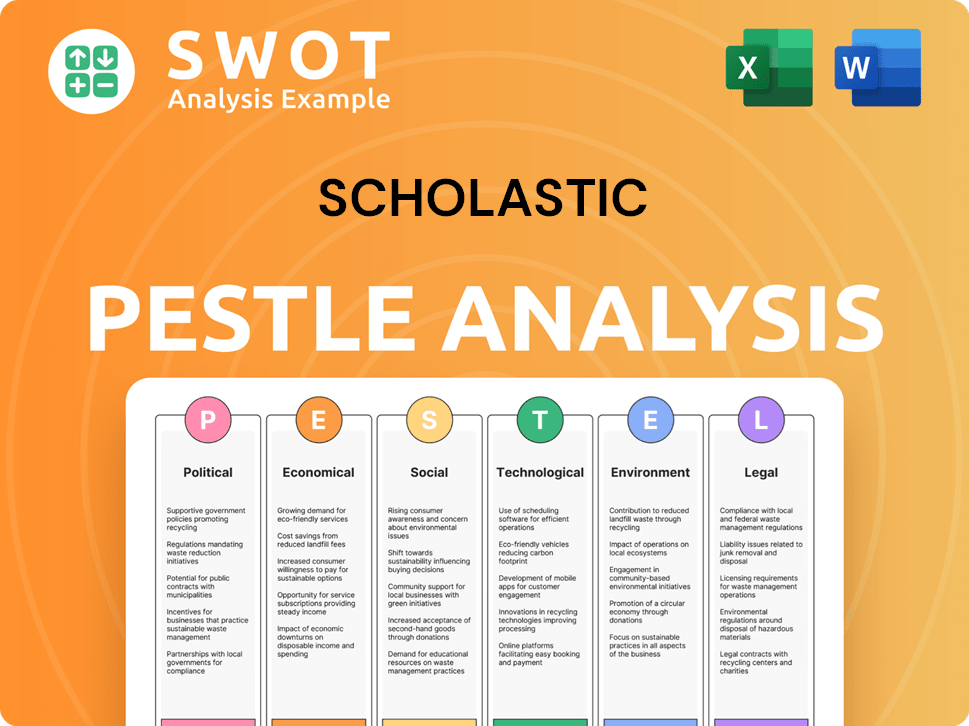
Which Strategic Decisions Have Shaped Scholastic’s Business Model?
The operational and financial performance of the Scholastic Company has been significantly shaped by key milestones and strategic decisions. A primary focus for the Scholastic Company is digital transformation and the expansion of its educational technology offerings. This involves the development of new digital learning platforms and resources to meet the rising demand for blended learning environments in schools. For instance, Scholastic continues to invest in platforms like Scholastic Learn at Home and other digital literacy tools to enhance its Education Solutions segment.
The company has also navigated operational challenges, such as supply chain disruptions, especially during and after the pandemic, which affected the timely delivery of books and materials. Scholastic responded by optimizing its logistics and inventory management to mitigate these issues and ensure product availability for its book fairs and direct sales channels. Market downturns and shifts in educational funding can also pose challenges, requiring Scholastic to adapt its sales strategies and product development to align with school budgets and priorities.
Scholastic's competitive advantages are robust and multi-faceted. Its brand strength is paramount, built over a century of trust with educators, parents, and children. The iconic Scholastic Book Fairs and Book Clubs provide unparalleled direct access to its target market, creating a powerful distribution network that is difficult for competitors to replicate. This direct engagement fosters strong customer loyalty and provides valuable insights into market demand. Additionally, Scholastic benefits from economies of scale in content creation, printing, and distribution, allowing it to produce and deliver materials efficiently. Its extensive library of beloved children's book titles and educational content provides a strong competitive moat. The company continues to adapt by investing in new technologies, expanding its digital footprint, and developing content that aligns with current educational standards and pedagogical approaches, ensuring its relevance in a rapidly evolving educational landscape. If you want to know more about the company, you can read Brief History of Scholastic.
Scholastic has a rich history, marked by significant achievements. Early milestones include the launch of Scholastic magazines and the expansion into book publishing. The introduction of Scholastic Book Fairs and Book Clubs revolutionized the distribution of children's books. These initiatives helped establish Scholastic as a leader in children's publishing and education.
Strategic moves include a focus on digital transformation and expanding educational technology. This involves developing digital learning platforms and resources. Scholastic has also made strategic acquisitions to strengthen its position in the market. These moves help Scholastic adapt to changing educational needs.
Scholastic's competitive edge comes from its strong brand and direct access to its target market. The Scholastic Book Fairs and Book Clubs are key distribution channels. Economies of scale in content creation, printing, and distribution also contribute to its advantage. Its extensive library of titles provides a strong competitive moat.
Scholastic's financial performance is influenced by book sales, book fairs, and educational solutions. The company's revenue and profitability are affected by market trends and educational funding. Scholastic continues to adapt its strategies to maintain its financial health. The company's revenue for fiscal year 2024 was approximately $1.6 billion.
Scholastic's success is driven by several key factors. These include a strong brand reputation and direct access to its target market through book fairs and clubs. The company's ability to adapt to digital trends and educational needs is also crucial. Scholastic continuously invests in new technologies and content development.
- Brand Recognition: Scholastic has a century-long history of trust.
- Distribution Network: Book Fairs and Clubs offer direct market access.
- Digital Transformation: Investments in digital learning platforms.
- Content Development: Creating materials aligned with educational standards.
Scholastic Business Model Canvas
- Complete 9-Block Business Model Canvas
- Effortlessly Communicate Your Business Strategy
- Investor-Ready BMC Format
- 100% Editable and Customizable
- Clear and Structured Layout
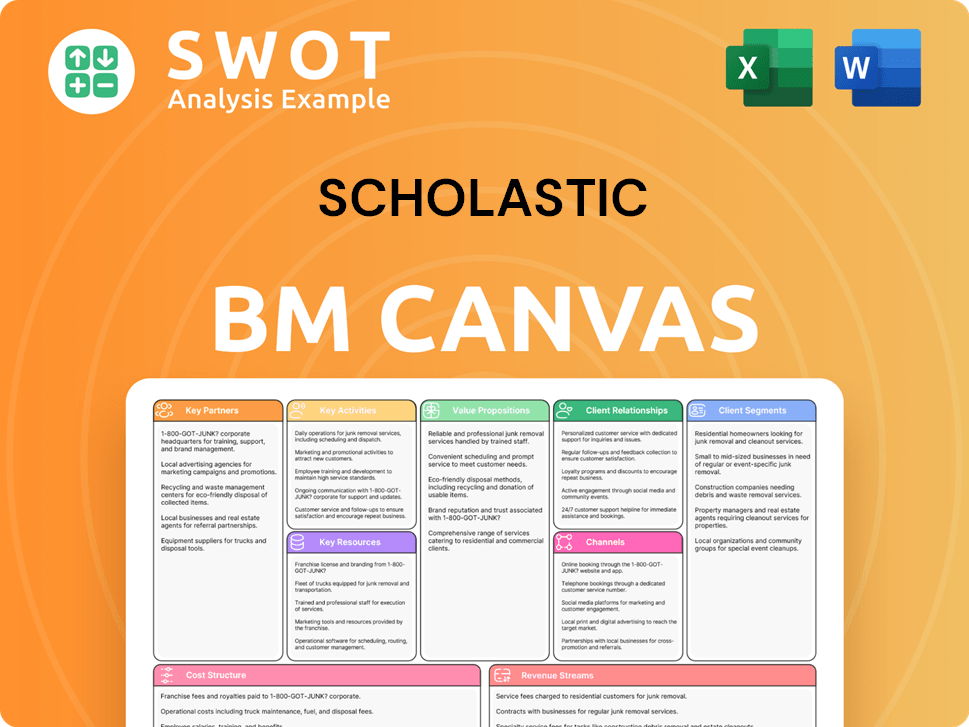
How Is Scholastic Positioning Itself for Continued Success?
The Scholastic Company holds a prominent position within the children's publishing and educational materials sector. It secures significant market share through its book clubs and book fairs, leveraging strong brand recognition and deep relationships with educators. Internationally, Scholastic maintains a substantial presence, operating and distributing in numerous countries, thus extending its reach beyond the U.S. market.
However, Scholastic confronts several key risks. The shift towards digital content, technological disruptions from educational technology companies, potential regulatory changes in education funding, and economic downturns all pose challenges. Competition from other publishers and self-publishing platforms further intensifies the landscape.
Scholastic is a leader in children's publishing and educational materials. Its book clubs and fairs give it significant market share. The company has strong brand recognition and relationships with educators.
The company faces risks such as the shift to digital content and competition. Technological disruptions and changes in education funding also pose threats. Economic downturns can impact revenue.
Scholastic is investing in digital platforms and educational technology. It aims to expand digital subscriptions and online learning solutions. The company plans to enhance its book publishing and distribution.
The company is committed to literacy and providing high-quality educational resources. It balances traditional strengths with digital expansion. This approach aims to ensure long-term growth and profitability.
Looking ahead, Scholastic is strategically focused on expanding its revenue streams. The company is investing in digital platforms and educational technology to meet the evolving needs of schools and students. Scholastic aims to leverage its brand strength and existing relationships to grow its digital subscriptions and online learning solutions. The company intends to enhance its core book publishing and distribution businesses by introducing new titles and engaging content. For more details on the company's financial structure, consider exploring Owners & Shareholders of Scholastic. Leadership emphasizes a commitment to literacy and providing high-quality educational resources, indicating a future direction that balances traditional strengths with innovative digital expansion.
The company is focusing on digital platforms, educational technology, and online learning solutions. It plans to enhance its core book publishing and distribution businesses. These strategies aim to ensure long-term growth and profitability.
- Investment in digital platforms and educational technology.
- Expansion of digital subscriptions and online learning solutions.
- Enhancement of book publishing and distribution.
- Focus on literacy and high-quality educational resources.
Scholastic Porter's Five Forces Analysis
- Covers All 5 Competitive Forces in Detail
- Structured for Consultants, Students, and Founders
- 100% Editable in Microsoft Word & Excel
- Instant Digital Download – Use Immediately
- Compatible with Mac & PC – Fully Unlocked
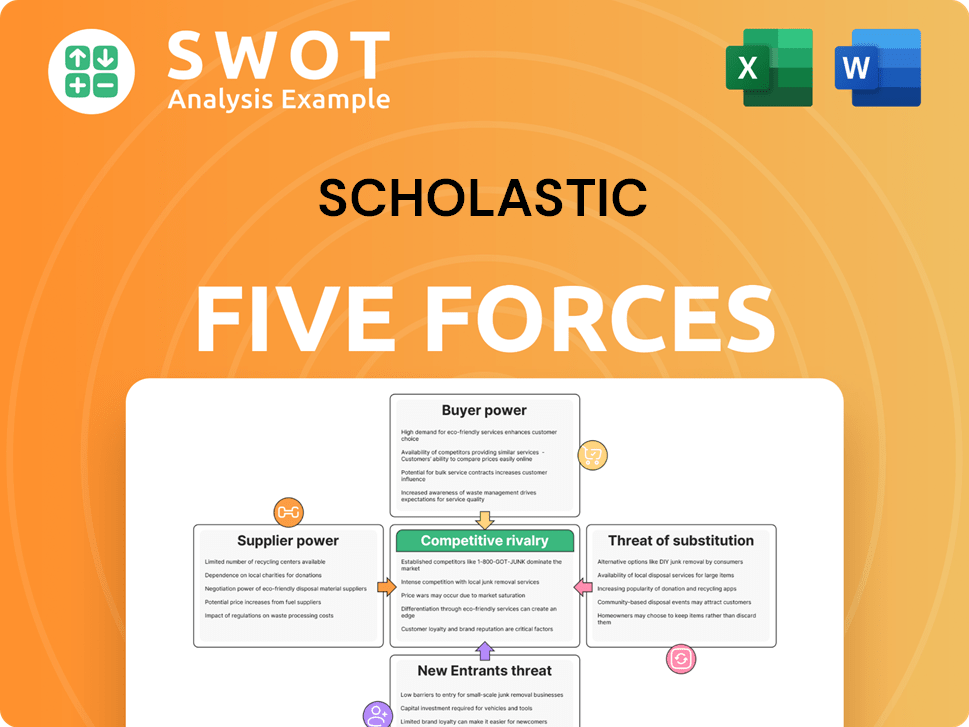
Related Blogs
- What are Mission Vision & Core Values of Scholastic Company?
- What is Competitive Landscape of Scholastic Company?
- What is Growth Strategy and Future Prospects of Scholastic Company?
- What is Sales and Marketing Strategy of Scholastic Company?
- What is Brief History of Scholastic Company?
- Who Owns Scholastic Company?
- What is Customer Demographics and Target Market of Scholastic Company?
Disclaimer
All information, articles, and product details provided on this website are for general informational and educational purposes only. We do not claim any ownership over, nor do we intend to infringe upon, any trademarks, copyrights, logos, brand names, or other intellectual property mentioned or depicted on this site. Such intellectual property remains the property of its respective owners, and any references here are made solely for identification or informational purposes, without implying any affiliation, endorsement, or partnership.
We make no representations or warranties, express or implied, regarding the accuracy, completeness, or suitability of any content or products presented. Nothing on this website should be construed as legal, tax, investment, financial, medical, or other professional advice. In addition, no part of this site—including articles or product references—constitutes a solicitation, recommendation, endorsement, advertisement, or offer to buy or sell any securities, franchises, or other financial instruments, particularly in jurisdictions where such activity would be unlawful.
All content is of a general nature and may not address the specific circumstances of any individual or entity. It is not a substitute for professional advice or services. Any actions you take based on the information provided here are strictly at your own risk. You accept full responsibility for any decisions or outcomes arising from your use of this website and agree to release us from any liability in connection with your use of, or reliance upon, the content or products found herein.